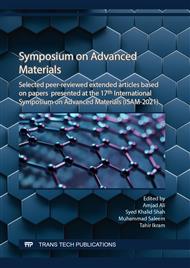[1]
P. Sae-Oui, K. Suchiva, C. Sirisinha, W. Intiya, P. Yodjun, U. Thepsuwan, Effects of blend ratio and SBR type on properties of carbon black-filled and silica-filled SBR/BR tire tread compounds, Adv. in Mater. Sc. and Engg. (2017).
DOI: 10.1155/2017/2476101
Google Scholar
[2]
F.M. Research, Carbon Black Market-Global Industry Analysis (2017 - 2020)-Growth Trends and Market Forecast (2021 - 2025), Global September (2021).
Google Scholar
[3]
Y. Fan, G.D. Fowler, M. Zhao, The past, present and future of carbon black as a rubber reinforcing filler – A review, J. Clean. Prod. 247 (2020) 19115.
DOI: 10.1016/j.jclepro.2019.119115
Google Scholar
[4]
L.G. Andersen, J.K. Larsen, E.S. Fraser, B. Schmidt and J.C. Dyre, Rolling resistance measurement and model development, J. Transp. Engg. 141 (2015) 04014075.
DOI: 10.1061/(asce)te.1943-5436.0000673
Google Scholar
[5]
G. Fontaras, N.-G. Zacharof, B. Ciuffo, Fuel consumption and CO2 emissions from passenger cars in Europe–Laboratory versus real-world emissions, Prog. in ener. and comb. Sc. 60 (2017) 97-131.
DOI: 10.1016/j.pecs.2016.12.004
Google Scholar
[6]
X. Sun, J. Liu, J. Hong, B. Lu, Life cycle assessment of Chinese radial passenger vehicle tire, Int. J. Life Cycle Assess. 21 (2019) 1749-1758.
DOI: 10.1007/s11367-016-1139-0
Google Scholar
[7]
M. Linec, B. Mušič, The effects of silica-based fillers on the properties of epoxy molding compounds, Materials, 12 (2019) 1811.
DOI: 10.3390/ma12111811
Google Scholar
[8]
V. Sethuramalingam, S. Prabagaran, K. Ganesan, Studies on influence of silica filler and rice husk ash on the mechanical properties of vulcanized hybrid rubber composite, Mater. Today: Proceedings, 37 (2021) 2207-2213.
DOI: 10.1016/j.matpr.2020.07.654
Google Scholar
[9]
S. Ilhan, D. Tuzun, A. Ozdemir, Comparative Properties of HTV Silicone Rubber for Composite Insulators—ATH and Silica Fillers, IEEE Trans. on Dielec. and Elec. Insulation, 28 (2021) 414-422.
DOI: 10.1109/tdei.2020.009183
Google Scholar
[10]
R.J. Dhanorkar, S. Mohanty, V.K. Gupta, Synthesis of Functionalized Styrene Butadiene Rubber and Its Applications in SBR–Silica Composites for High Performance Tire Applications, Ind. & Engg. Chem. Res. 60 (2021) 4517-4535.
DOI: 10.1021/acs.iecr.1c00013
Google Scholar
[11]
Q. Tian, Y. Tang, T. Ding, X. Li, Z. Zhang, Effect of nano-silica surface-capped by bis [3-(triethoxysilyl) propyl] tetrasulfide on the mechanical properties of styrene-butadiene rubber/butadiene rubber nanocomposites, Comp. Comm., 10 (2018) 190-193.
DOI: 10.1016/j.coco.2018.10.005
Google Scholar
[12]
S. Sattayanurak, J.W. Noordermeer, K. Sahakaro, W. Kaewsakul, W. Dierkes, A. Blume, Silica-reinforced natural rubber: synergistic effects by addition of small amounts of secondary fillers to silica-reinforced natural rubber tire tread compounds, Adv. Mat. Sc. and Engg. (2019).
DOI: 10.1155/2019/5891051
Google Scholar
[13]
K. Saur, M. Schuckert, J. Gediga, H. Florin, J. Hesselbach, LCA Study on Tires With Reduced Roll Resistance, SAE transactions, (1997) 2149-2153.
DOI: 10.4271/971159
Google Scholar
[14]
Ľ. Ambriško, D. Marasová, Evaluation the quality of rubber composites using the DOE method, Calitatea, 18 (2017) 60.
Google Scholar
[15]
R. Kolahdooz, S. Asghari, S. Rashid-Nadimi, A. Amirfazli, Integration of finite element analysis and design of experiment for the investigation of critical factors in rubber pad forming of metallic bipolar plates for PEM fuel cells, Int. J. Hydr. Ener. 42 (2017) 575-589.
DOI: 10.1016/j.ijhydene.2016.11.020
Google Scholar
[16]
S. Zhang, C. Zhang, J. Zhang, T. Yuan, W. Li, D. Wang, et al., Design and experiment of suspension-typed rubber tapping device, Int. Agri. Engg. 27 (2018) 110-118.
Google Scholar
[17]
J. S. Dick, Rubber technology: compounding and testing for performance: Carl Hanser Verlag GmbH Co KG, (2020).
Google Scholar



